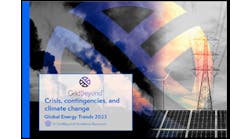Puerto Rico’s Utility Calls for Making the Island into Eight Minigrids
Puerto Rico’s utility is calling for segmenting the island’s electrical grid into eight minigrids, myriad microgrids and installing more energy storage than is now in all 50 US states.
The concept is outlined in a draft integrated resource plan (IRP) that the Puerto Rico Electric Power Authority (PREPA) plans to finalize and submit to regulators February 12.
IRPs are guiding documents that utilities throughout the US produce to determine the least-cost way to manage gaps between existing resources and future needs. Their development is carefully watched by the power industry since the plans often reveal market opportunities, particularly how much generation — and what kind — the utility will procure.
Since demand for electricity is declining in Puerto Rico, this IRP strays from classical utility planning. Rather than outlining new power supply needs, it focuses on reshaping the island’s grid to decentralize power production and deliver it independent blocks — a way to help avoid the massive power outages caused by Hurricane Maria in 2017.
The eight connected minigrids, a term often used in North America to describe a large and complex microgrid, would have the ability to operate independently when necessary — such as when a storm knocks out transmission lines. The minigrids would be sited to support clusters of critical transmission and distribution voltage loads, downstream of distribution and transmission vulnerabilities, according to the IRP, which was prepared for PREPA by Siemens Power Technology.
Microgrids within minigrids
To further increase the island’s energy resiliency, the IRP plan calls for various smaller microgrids installed within the minigrids. Microgrids also would be built in remote areas of Puerto Rico not easily accessed by transmission lines or suitable for a minigrid.
“PREPA’s large central generators, located far away from load centers, made it vulnerable to disruption as we saw after Maria. Renewable energy microgrids will help to support resiliency in response to climate change, and access to critical services after hurricanes,” said Jeremy Fisher, senior strategy and technical advisor at Sierra Club. “Having access to power after a disruption could make the difference between life and death for many people on the island.”
Several microgrids already have been built on the island by private companies and government since the hurricane. Meanwhile, various players, including AES and Siemens, have put forward the idea of segmenting Puerto Rico into minigrids since Hurricane Maria toppled most of the island’s grid in late 2017.
PREPA’s plan calls for various smaller microgrids installed within the minigrids. Microgrids also would be built in remote areas of Puerto Rico not easily accessed by transmission lines or suitable for a minigrid.
Greening Puerto Rico
Under the plan Puerto Rico would significantly green its energy supply over the next four years, adding 750-1,200 MW of solar — an aggressive interconnection pursuit for an isolated system, according to the IRP. The utility would issue competitive solicitations for the solar in 250 MW blocks.
Along with the solar, the island would install 500 to 1,100 MW of battery energy storage over four years. This could exceed the total amount of battery storage, 1031 MW, now installed on the US grid, according to the Sierra Club, citing data from Bloomberg New Energy Finance.
In preparation for the high level of distributed energy added to the system, PREPA would reinforce and upgrade its distribution system to enable two-way flow of energy and provide voltage regulation and flicker control.
The plan also includes 17-18 small natural gas-fired generators of about 23 MW each. PREPA says they are necessary to maintain the minigrids should a hurricane force the minigrids to operate independently for a month or more.
The island would retire most of its fossil fuel power plants by 2025 but would keep operating two combined cycle gas-fired plants in San Juan and Aguirre and gas turbines in Mayagüez and Cambalache. The island would also build two liquified natural gas terminals — an aspect of the IRP already drawing fire from environmental activists.
PREPA may seek microgrid regulation changes
Puerto Rico has jumped ahead of the states by creating microgrid regulations and tariffs last year. However, PREPA said in the IRP that it may seek some changes to the regulations. The utility says it supports microgrids but takes issue with certain aspect of the regulation and may seek changes. For example, it opposes the ability given customers to switch in and out of PREPA service, an option “that no utility could accept.”
In its long-term planning, PREPA intends to identify microgrids that could be owned by either the utility or private entities.
The draft plan follows years of crushing market conditions for Puerto Rico’s energy sector. Electricity sales have fallen 18 percent since the 2008 recession. From 2007 through 2017, Puerto Rico’s real gross national product shrank by 17 percent and the population dropped by over 15 percent. Hurricane Maria contributed to a 22 percent drop in energy sales in 2018, according to the IRP.
The IRP forecasts a continued decline in electricity sales over its 20-year forecast, from 15,301 GWh this year to 14,654 GWh in 2038. However, 2019 may see a temporary leap in sales — 15 percent — as the island continues to rebuild from the Hurricane Maria.
PREPA intends to submit the final IRP to the Puerto Rico Energy Commission February 12. The commission will develop a procedural schedule and set up a formal review process, which will include a period for comment by intervenors. The commission will then issue an order approving, disapproving, or modifying the IRP.
The draft IRP is available here.
Track news about Puerto Rico’s minigrid plans. Subscribe to the free Microgrid Knowledge newsletter.







